Jeff Gordon, on the 2013s...and a little stock car racing history
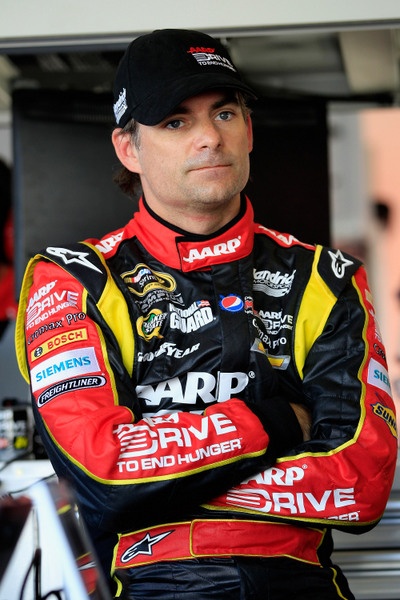
Jeff Gordon: still driving-for-five. (Photo: Getty Images for NASCAR)
By Mike Mulhern
mikemulhern.net
(Updated)
DAYTONA BEACH, Fla.
The Gen-6.
Coming through.
Catchy.
So bury the car-of-tomorrow. The COT, after six years, is finally history.
Drivers cheer, and crew chiefs can now say, again, 'I told ya so.'
And what will fans say?
Whenever there's a big change like this, I wonder what Banjo Matthews might think.
Heck, he'd be right in there amongst 'em, figuring out how to trick things up, I'm sure.
Good ol' Banjo was always my go-to guy, whenever I had a hard technical question, or just needed some good big picture philosophy about this sport.
Banjo Matthews was the extraordinarily talented car builder whose Asheville, N.C. shop was always busy Mondays after a big race in the 1970s and 1980s, with stock car teams lined up outside the front door with their damaged cars anxious for his magical repair work. That, after a career as car owner, with men like Fireball Roberts, Junior Johnson, Cale Yarborough and Donnie Allison.
Banjo, who died in 1996, was more, much more. He understood racing and race cars -- what worked and what didn't -- better than just about anyone in the business. And he is one of those men who helped make NASCAR racing what it is today, though few if any in this town today even remember him.
But Banjo Matthews was more than that. On Sundays at the track, he liked to sit around the press room and chew the fat with journalists, who hung on his every word, for those bits of wisdom to make sense out of the arcane engineering of this sport. And with a glance out at the track, he'd offer droll analysis. Banjo's sense of humor was a bit like Matt Kenseth's -- you had to be listening closely and watch his eyes, through those banjo-thick glasses.
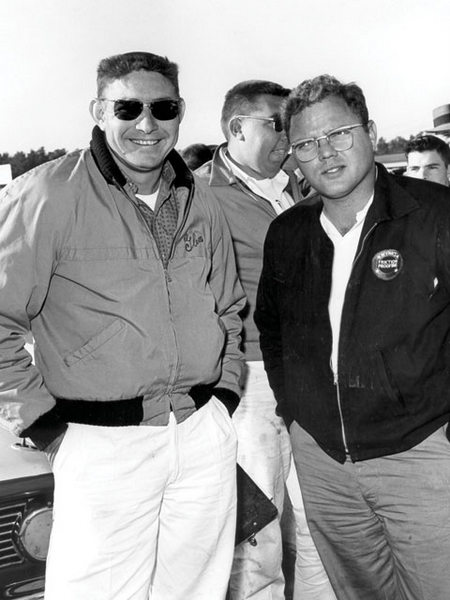
Banjo Matthews (R) and Fireball Roberts (Photo: Daytona)
Well, Banjo isn't around any more to help us out. So we'll have to make do on our own with this 'Gen-6.'
And the guy to listen to may be Jeff Gordon.
Remember 1997: 1997 Daytona 500 finish
And you wonder about the yellow line rule.....
A question now -- which car maker, Toyota, Ford or Chevrolet, has done the best homework on the new NASCAR stocker. While the buzz is that Toyota has a leg up, the logic is that 2013 will be another Chevy season on the stock car trail.
To hear Rick Hendrick's Chevy guys talk, yep.
Gordon:
"I didn't even know there was a Gen-1, Gen-2, Gen-3, Gen-4 or Gen-5, until this," Gordon says with a laugh.
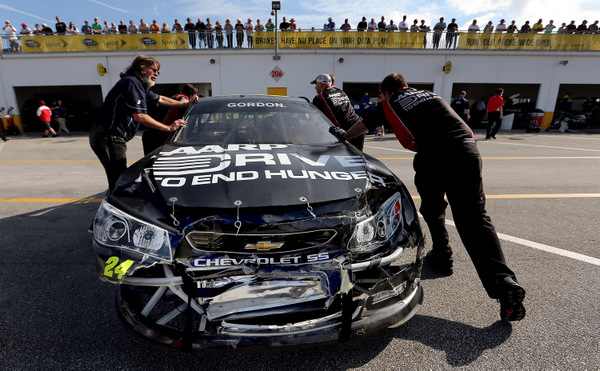
Daytona testing of the new 2013s didn't go all that well for Jeff Gordon (Photo: Getty Images for NASCAR)
NASCAR PR men have dubbed the new 2013 stocker a 'Generation Six' model.
The Gen-6, a cool name... though it may be a stretch to classify NASCAR
history from 1948-2013 so neatly into six categories.
However it's a good launching point for considering some of that wild,
glorious history.
The official NASCAR timeline:
Gen 1, the cars from 1948-1966.
Gen 2, 1967-1980.
Gen 3, 1981-1991.
Gen 4, 1992-2006.
Gen 5, 2007-2012.
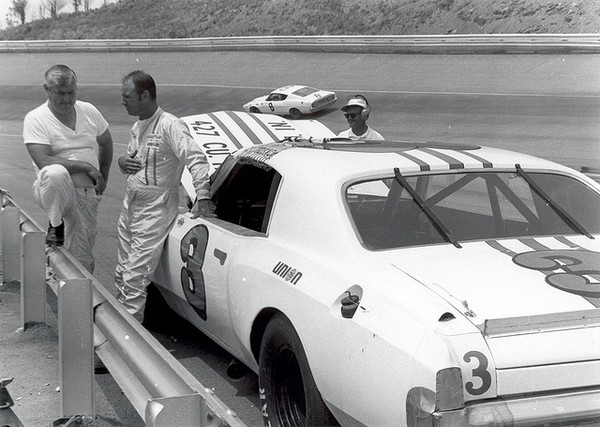
Junior Johnson (L) and Charging Charlie Glotzbach (Photo: Bristol)
A little history here.
From NASCAR's start in the late 1940s and early 1950s, stock cars were
generally rather liberally created, subject to NASCAR inspection whims and
Bill France Sr.'s interpretations.
One of the biggest changes in NASCAR stockers came in 1966-1967,
following a terrible stretch of fiery death and destruction, like Fireball
Roberts' Charlotte crash, when safety and big-time manufacturing operations
took center stage.
Think Holman-Moody, Banjo Matthews, and Dick Hutcherson-Eddie Pagan.
Think Dodge and Ford engineers and the rollbar cage safety design. Credit
Detroit car makers for making stock car racing much safer. The safety fuel cell, from Vietnam helicopters...
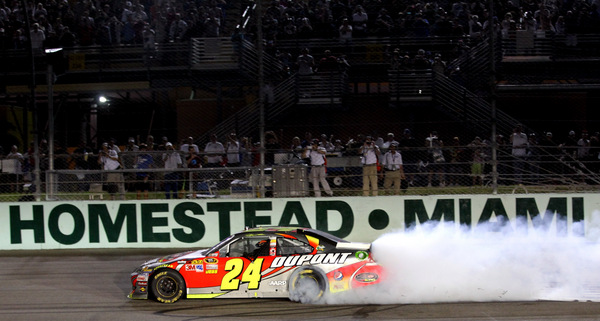
Jeff Gordon bounced back from that Phoenix controversy to win Homestead last fall (Photo: Getty Images for NASCAR)
Another major -- more controversial -- change in car design came in
1981, when NASCAR downsized its cars, to a 110-inch wheelbase and, more
importantly, stuck drivers with Detroit's notchback rear ends, which were a
general disaster from a racing standpoint. Just consider the aerodynamics
problems of a notchback.
Ford engineers did, and re-entered the sport with that super-aerodynamic
Thunderbird, making Bill Elliott a star and sending GM back to the drawing
board. Chevrolet's 1986-1987 'aero-coupe,' a rather liberal creation,
followed NASCAR's still-curious 1985 edict to crew chief Gary Nelson to do
anything to build a car that could beat Elliott's Thunderbird. That
summer's Daytona 400, well, it was one for the books.
The next significant body-chassis design shakeup came around 1992, one
of the best seasons ever in this sport. Alan Kulwicki, a NASCAR legend, won
the 1992 championship in an epic battle. Over the next several years car
bodies became what some called 'Twisted Sisters,' with bodies squeezed and
contorted, and with body placed on the chassis in a wide variety of
designs, varying from track to track and from driver to driver.
All that is classic racing, doing whatever it takes. But the demands on
wind tunnel time became outrageous, and the cars themselves began to look
very weird.
Not that the racing wasn't good. In fact racing from 1992 through 2006
was some of the best in NASCAR history, a period that may someday be seen
as one of this sport's golden ages.
Alas, NASCAR executives decided, for some reason, to create their own
stock car. Ostensibly it was a safer car, and many of the changes were very
good for safety. However, the sense was more that NASCAR wanted more
control at the inspection station, and it got that, with a stunning number
of inspection changes. The cars themselves became virtually
indistinguishable in primer, however. Brand identify vanished. Teams
complained the new rules put them in a box, with the 'common template'
rules.
NASCAR, despite vociferous complaints from drivers and crew chiefs,
never wavered. The COT was roundly criticized for its poor handling
characteristics. NASCAR threw a rear wing on the COT, for some reason; it
was rejected, and eventually discarded.
Car makers began a quiet revolt. The expense of playing the NASCAR game
was simply too much, for a race car that didn't look much at all like what
people were driving on the streets.

A little dust-up in the desert (Photo: Getty Images for NASCAR)
"It was crazy," Gordon said of the stretch from 1992 through 2006. "And there was a little bit of an over-reaction (by NASCAR), because of what was happening with the cars. Every car looked different. And there was a performance gap whenever someone would twist it up a little more.
"You'd go through inspection, and the inspectors are scratching their heads trying to figure out how you did what you did and still met the templates.
"It was fun for the teams: 'Oh, let's go try this.' There was fun ingenuity. And when they'd hit it right, those cars would be fun to drive.
"But I look back at some of those cars and, gosh, they almost started looking ugly, as twisted up as they were. Still they looked like race cars and made a lot of downforce."
The 2013s, if it all goes according to plan, should have downforce on the mid-sized tracks and still look sharp. How they work here, though, is still up for debate.
"If people think that this new car will all of a sudden change everything, well, it may change the perception... and it will give us a little extra confidence," Gordon says.
"Throughout my career, whenever we get more downforce we gain confidence.
"This car will give us confidence...and the drama might come from having too much confidence -- diving in there and maybe it doesn't stick.
"But until we get around each other banging fenders, we won't really know."
That shouldn't be long in coming. The Unlimited/Shootout is Saturday night.
Will this be a Chevy year, a Ford year, or a Toyota year?
Brad Keselowski's 2012 championship for Dodge ended a seven-year run for Chevy at NASCAR's head table.
Chevrolet has been a major player in stock car racing going back to the 1950s. While Dodge/Chrysler and Ford got more headlines, Chevy was also a player, though much of the time under the table, with secret support of NASCAR teams, while Detroit brass looked the other way.
Remember 1957? A great season for Chevrolet....as long as it lasted. The small block V-8. The Black Widows...which would probably be more well known if General Motors hadn't decided to officially pull out of racing so suddenly, during a short-lived but damaging anti-racing fervor.
GM didn't officially get back into NASCAR until the late 1970s.
But Chevy played a big role in this sport while officially on the sidelines.
-- Junior Johnson's 'mystery' 427 Chevy in 1963 wound up being the legendary porcupine engine.
-- Charlotte promoter Richard Howard, another stock car racing legend, and one of the men who 'saved' the sport during the dark days of the early 1970s, persuaded Johnson to put Charging Charlie Glotzbach in a Chevy for the 600 in 1971.
-- Bobby Allison and those 'Coke' machines....
Eventually GM got back into NASCAR racing, on the books, in the late 1970s.
Back then stock cars looked a lot like street cars. Bill Elliott's famous 1983 and 1985 Thunderbirds...even Dale Earnhardt's 1987 fastback Monte Carlo (did it really have a smaller than legal greenhouse?)
For years Jeff Gordon was 'the kid,' seemingly a perennial 24... and now, approaching 42, an elder statesman.
Once the lead dog in Hendrick's pack, Gordon has played largely in the shadow of teammate Jimmie Johnson lately.
"It's not about Jimmie; it's about not living up to your own expectations," Gordon insists.
"You know you've got an organization that gives you the best cars, and you're not performing at the level it's capable of.
"I was a little frustrated in '07, when Jimmie and I went for the championship. They gave us an opportunity at Charlotte; they made a mistake, and we won the race. But they came back and just took it back.
"It was real frustrating that we couldn't step up."
That was an epic duel. It was also a season where Gordon posted the best overall record...only to get tripped up by the 10-race chase format.
"Phoenix was our Achilles Heel," Gordon recalled. "It's not been our best track, and it's one of Jimmie's best. We went there and just did not perform. I blame myself.
"That turned the whole thing around."
Phoenix a few months ago was another bad day for Gordon, with that run-in with Clint Bowyer.
But he followed that with a solid win in the Homestead finale.
"We had a real up and down year. After the drama at Phoenix we needed to end the season on a high note.
"We haven't won as much, and you hear people say 'Jeff used to be more aggressive.' But you need to be in position to do that. And when I have the opportunity, I'm going to do it.
"On the flip side, when I think I'm getting taken advantage of, I'm going to show my passion as well.
"Yes, that energized a lot of my fans. Certainly drew a lot of attention. I'm glad my fans know how much it means to me to compete for wins and not just drive around."
Last season was, really, a solid one for Gordon, if not for awful luck. He ran strong at most tracks, could have had a shot at the title, with crew chief Alan Gustafson.
And those opportunities won't be coming along that much longer. He doesn't see himself in the Mark Martin 'ageless' mold.
Daytona is its own creature, and the new stocker has much different characteristics for SpeedWeeks than it will have at the rest of the tour's tracks. Gordon points to Phoenix, Las Vegas and California as three tracks that should give a better indication of who has what for the championship run.
This championship?
"We haven't won one since '01," Gordon says. "Yes, we should be winning races. I feel we've made some great adjustments during the off season, and this can be a very special year for us.
"If you just go out there and have spectacular seasons every year, people get tired of it. With me, it hasn't always been that way."
"It's made me work harder at it. And be more appreciative of the good times when they come."
The new stocker, Gordon says, will certainly change the game. It's just no one is quite sure in what ways.
"Any time you change things, there's a bit of a learning curve. And the older you get, the harder it is to switch and learn new things," Gordon says. "So there will be times where we'll be challenged.
"Like at the repaves (Phoenix for one), with the hard tires, that's where I struggle the most. That's where I'll have to work the most.
"At tracks where the speeds don't fall off, track position is so important.
"The abrasive tracks (like Kentucky), where you have to finesse the car, find different lines, and work with the team to manage the tires on long runs, that's always been my strong suit."
Darlington, now that it's got some wear on the asphalt, could be another good one for Gordon.
Gordon is optimistic.
"This new car does feel good, because it's got good grip and a ton of rear spoiler and a lot more downforce (except at Daytona). It's a fun car to drive. The teams can adjust on different things, in the front and the rear.
"We're still learning the car aerodynamically.
"But I'm enjoying this car."
Maybe that will mean more action....and more cautions...and more of those titillating double-file restarts.
"We 'lost' a lot of cautions last year," Gordon says. "We're just not seeing as many. That creates issues...."
Particularly in the grandstands and in front of the tube.
That trick rear end chassis setup Hendrick's engineers perfected last summer worked to Gordon's advantage, he says.
But that's history now; new rules have banned that trick.
"The new car is just different, and we're learning," he says. "And because it does have more downforce, the question is 'How hard can I push this car?'
"....How to get on the throttle in the middle of the corner....
"...what it will be like to run side by side...what will happen when you rub the wall...how will it damage the car.
"The front of the car is not as strong. And if you tear that fender up, it could have a much more dramatic effect.
"But the positives far outweigh the negatives. As a driver and as a dealer, I'm excited.
"With the new nose, a lot will depend on how the air wraps around and follows the contours of the car and gets to the rear spoiler (especially at Daytona). The spoiler at Daytona is what makes you go slow or go fast.
"The whole thing is driving style...and when you get to this point in my career, I can't change my style.
"Sometimes my teammates will be running good but that setup won't work in my car.
"The key for me is to remind myself what's made me successful. But also not to frustrate the team too much when something is not working for me. "
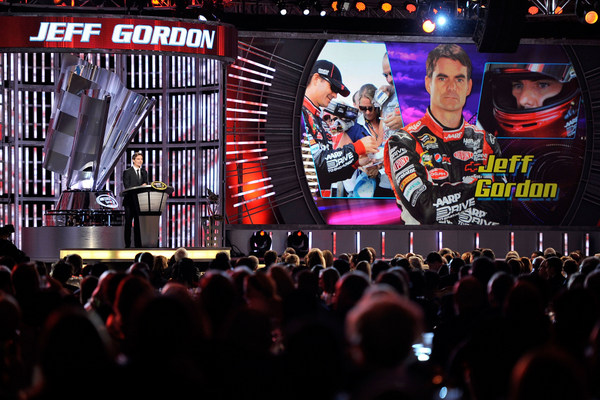
© 2010-2011 www.mikemulhern.net All rights reserved.
Web site by www.webdesigncarolinas.com







Gordon can talk championships all he wants, but
Gordon can talk championships all he wants, but time has passed him by. Richard & Dale got all their championships between age 27 and 43, while Jeff's good years only lasted from age 24 to 30.
He may ring up 3rd or 4th in the coming championship years but he doesn't have the skills he once did and his comfortable lifestyle won't require him to bear down and make it happen.
And keep in mind the way Dale Earnhardt Sr got
And keep in mind the way Dale Earnhardt Sr got all 7 of his Cups: having the most points at the end of the year. Jeff has done that 6 times; but the "playoffs" changed how the Championship is rewarded. Jeff is still (and likely always will be) a 4 time Champion, but that's not to say that he hasn't had any other "championship" runs since 2001. 2004 and 2007 are his on the regular season "championship", and in the overall earned points. It doesn't officially count, but it does to an extent.
Post new comment